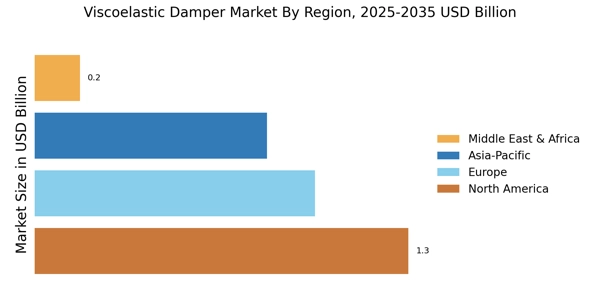Expansion of the Automotive Sector
The expansion of the automotive sector is contributing to the growth of the Viscoelastic Damper Market. As vehicle manufacturers increasingly prioritize ride comfort and safety, the integration of viscoelastic dampers in automotive applications is becoming more prevalent. These dampers are utilized in suspension systems to reduce vibrations and enhance driving experience. The automotive industry is projected to grow at a rate of 4.5% annually, with a notable shift towards electric and hybrid vehicles, which often require advanced damping solutions. This shift presents a unique opportunity for the Viscoelastic Damper Market to innovate and cater to the evolving needs of the automotive sector. As such, the demand for viscoelastic dampers in vehicles is likely to see a substantial increase in the coming years.
Rising Awareness of Seismic Safety
The growing awareness of seismic safety is significantly influencing the Viscoelastic Damper Market. With an increasing number of regions prone to earthquakes, there is a heightened focus on implementing effective seismic protection measures in construction. Viscoelastic dampers are recognized for their ability to absorb and dissipate energy during seismic events, thereby minimizing structural damage. Recent studies indicate that buildings equipped with viscoelastic dampers can reduce seismic forces by up to 40%, making them an attractive option for architects and engineers. As a result, the demand for these dampers is expected to rise, particularly in earthquake-prone areas. This trend underscores the importance of viscoelastic dampers in enhancing the safety and resilience of structures, thereby driving growth in the Viscoelastic Damper Market.
Increasing Infrastructure Investments
The Viscoelastic Damper Market is experiencing a surge in demand due to increasing investments in infrastructure projects. Governments and private entities are allocating substantial budgets for the development of roads, bridges, and high-rise buildings. This trend is particularly evident in urban areas where the need for seismic protection and vibration control is paramount. The integration of viscoelastic dampers in these structures enhances their resilience against dynamic loads, thereby ensuring safety and longevity. According to recent data, the infrastructure sector is projected to grow at a compound annual growth rate of approximately 5.4% over the next five years, further propelling the demand for viscoelastic dampers. As such, the Viscoelastic Damper Market stands to benefit significantly from this upward trajectory in infrastructure spending.
Regulatory Support for Energy Efficiency
Regulatory support for energy efficiency is emerging as a key driver for the Viscoelastic Damper Market. Governments worldwide are implementing stringent regulations aimed at reducing energy consumption in buildings and infrastructure. Viscoelastic dampers contribute to energy efficiency by minimizing vibrations and enhancing the overall performance of structures. This regulatory landscape encourages the adoption of advanced damping technologies, as compliance with energy efficiency standards becomes increasingly critical. Recent legislation in various regions mandates the use of energy-efficient materials in construction, which is likely to boost the demand for viscoelastic dampers. Consequently, the Viscoelastic Damper Market is positioned to benefit from these regulatory initiatives, fostering a more sustainable approach to construction and infrastructure development.
Technological Innovations in Material Science
Technological advancements in material science are playing a pivotal role in shaping the Viscoelastic Damper Market. Innovations in polymer formulations and composite materials have led to the development of more efficient and durable viscoelastic dampers. These advancements not only improve the performance of dampers but also reduce their weight and cost, making them more appealing for various applications. For instance, the introduction of smart materials that can adapt to changing environmental conditions is gaining traction. This evolution in material technology is expected to drive the market forward, with estimates suggesting a potential increase in market size by 7% annually over the next few years. Consequently, the Viscoelastic Damper Market is likely to witness a transformation as these new materials become mainstream.


















Leave a Comment